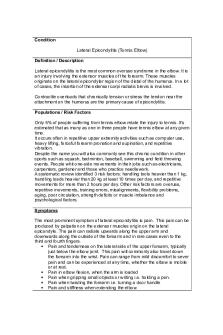The Clinical Picture and the Causal Pattern PDF

| Title | The Clinical Picture and the Causal Pattern |
|---|---|
| Author | quebo cabe |
| Course | Abnormal Psychology |
| Institution | University of Lethbridge |
| Pages | 1 |
| File Size | 38 KB |
| File Type | |
| Total Downloads | 99 |
| Total Views | 158 |
Summary
The Clinical Picture and the Causal Pattern...
Description
The Clinical Picture and the Causal Pattern Virtually all psychological disorders (especially depression) increase the risk of suicidal behaviour, and most people who die by suicide have a prior mental disorder. Notably, the risk of transitioning from suicidal thoughts to suicide attempt is highest in the first year after onset of suicidal thinking, and the longer a person goes thinking about suicide without making a suicide attempt, the less likely that individual is to ever make an attempt. Non suicidal self-injury (NSSI) = direct, deliberate destruction of body tissue (often taking the form of cutting or burning one’s own skin) in the absence of any intent to die. Women are more likely than men to think about suicide and to make nonlethal suicide attempts, but men are four times more likely than women to die by suicide. Suicide tendencies increase from the age of 12 onwards to 45, after which they decrease. Different disorders predict different parts of the pathway to suicidal behaviour. There is strong evidence that suicide sometimes runs in families and that genetic factors may play a role in the risk for suicide (partly independent from depression). The interpersonal-psychological model of suicide the psychological states of perceived burdensomeness (e.g., feeling like a burden to others) and thwarted belongingness (e.g., feeling alone) interact to produce suicidal thoughts and desires. The presence of the acquired capability for suicide (believed to be acquired through pain or provocative experiences) gives a person the desire and ability to do it. Suicide Prevention and Intervention Currently, there are three main thrusts of preventive efforts: o treatment of the person’s current mental disorder(s) antidepressant medications o crisis intervention, emergency medical treatment, followed by referral to inpatient or outpatient mental health facilities o working with high-risk groups....
Similar Free PDFs

Clinical Pattern sheet
- 10 Pages

Medial meniscus clinical pattern
- 3 Pages

COPD - clinical pattern sheets
- 2 Pages

GROSS ANATOMY THE BIG PICTURE
- 514 Pages

The picture of dorian gray
- 169 Pages

The Picture of Dorian Gray
- 8 Pages

Week 13 - The Big Picture
- 1 Pages
Popular Institutions
- Tinajero National High School - Annex
- Politeknik Caltex Riau
- Yokohama City University
- SGT University
- University of Al-Qadisiyah
- Divine Word College of Vigan
- Techniek College Rotterdam
- Universidade de Santiago
- Universiti Teknologi MARA Cawangan Johor Kampus Pasir Gudang
- Poltekkes Kemenkes Yogyakarta
- Baguio City National High School
- Colegio san marcos
- preparatoria uno
- Centro de Bachillerato Tecnológico Industrial y de Servicios No. 107
- Dalian Maritime University
- Quang Trung Secondary School
- Colegio Tecnológico en Informática
- Corporación Regional de Educación Superior
- Grupo CEDVA
- Dar Al Uloom University
- Centro de Estudios Preuniversitarios de la Universidad Nacional de Ingeniería
- 上智大学
- Aakash International School, Nuna Majara
- San Felipe Neri Catholic School
- Kang Chiao International School - New Taipei City
- Misamis Occidental National High School
- Institución Educativa Escuela Normal Juan Ladrilleros
- Kolehiyo ng Pantukan
- Batanes State College
- Instituto Continental
- Sekolah Menengah Kejuruan Kesehatan Kaltara (Tarakan)
- Colegio de La Inmaculada Concepcion - Cebu








